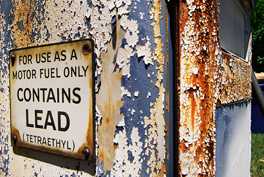LEAD

Information for Workers
How Lead Exposures Can Happen
If lead exposure is a possibility in your job, it is important that you understand how exposure occurs. This way you can take steps to lower your chances of being exposed
You can be exposed by breathing-in lead fumes or lead dust.
Lead fumes are produced during metal processing, when metal is being heated or soldered. Lead dust is produced when metal is being cut or when lead paint is sanded or removed with a heat gun.
Lead fumes and lead dust do not have an odor, so you may not know you are being exposed.
You can be exposed by ingesting lead dust.
Lead dust can settle on food, water, clothes, and other objects. If you eat, drink, or smoke in areas where lead is being processed or stored, you could ingest lead dust. Not washing your hands before you eat or touch your mouth are also ways you could ingest lead.
Though not always the case, ingested lead may leave a metallic taste in your mouth.
You can be exposed by coming in contact with lead dust.
Some studies have found lead can be absorbed through skin. 1 If you handle lead and then touch your eyes, nose, or mouth, you could be exposed. Lead dust can also get on your clothes and your hair. If this happens, it’s possible that you may track home some of the lead dust, which may also expose your family.
References
1U.S. Department of Health and Human Services [2007] Toxicological profile for Lead (update) [ http://www.atsdr.cdc.gov/toxprofiles/tp13.pdf (PDF 4.8 MB, 582 pages)] Public Health Service Agency for Toxic Substances and Disease Registry.
- Page last reviewed: April 19, 2017
- Page last updated: April 19, 2017
- Content source:
- National Institute for Occupational Safety and Health
Division of Surveillance, Hazard Evaluations and Field Studies
- National Institute for Occupational Safety and Health


 ShareCompartir
ShareCompartir